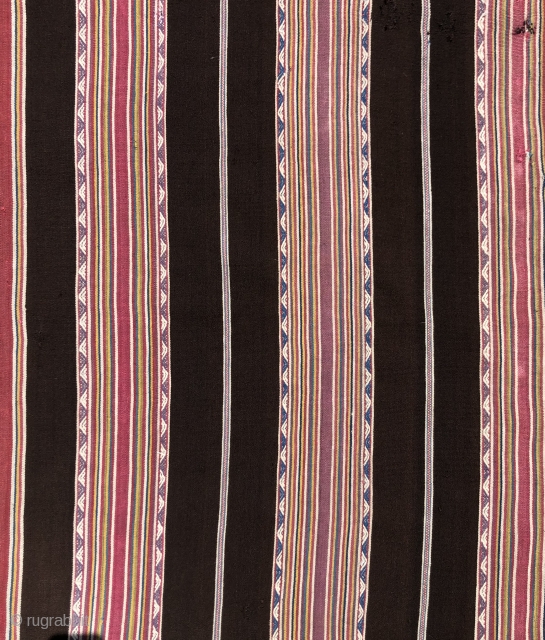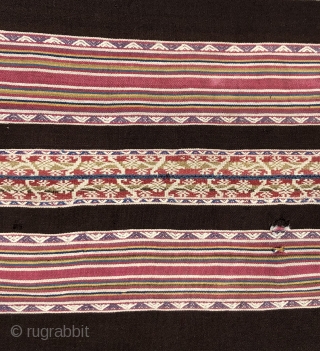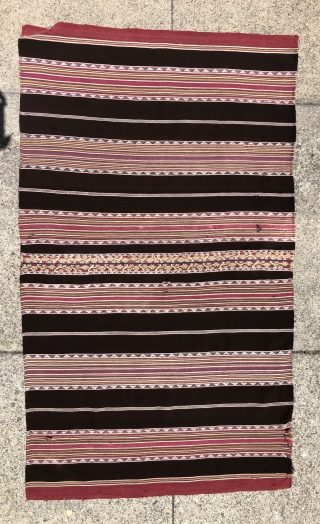Back
Fragment of a large and important Aymara Poncho from the first part of the 19th century or before. Ponchos such as this example were among the most prestigious weavings made by the Aymara. The indigenous Aymara Indians lived at about 12,500 feet above sea level on the Bolivian Altiplano and were primarily pastoralists herding vast herds of Alpacas and Llamas since ancient times. They also survived doing subsistence farming and as traders trekking caravans of Llamas who would carry up to 90 pounds on their backs - transporting goods along the spine of the Andes. The Aymara are traditionally regarded as the finest weavers in the highland region of the Andes of South America in the post conquest period. a poncho such as this would have been worn by a man of great distinction within his Aymara community. Large ponchos of this size and scale were referred to as "Balandrone ponchos" signifying that they were worn by very important men for ceremonial occasions. This fragment is about 1/2 of the original poncho and measures 38 x 63 inches as is. It was re-sewn into its present form using two sections of the original poncho. It has lost some of its former glory by being reduced, but is now in a size/format that is easy to display and very familiar to rug collectors. It makes a very impressive hanging to live with and like an old kelim fragment is completely legit - and it is quite affordable. Aymara weavings are warp-faced textiles and are finer than anything produced in the old world in this structure. The closest textiles from the Near East and Central Asia in fineness would be the very finest of the Shah Sevan warp-faced plain weave bedding covers, but even the finest of these are not as fine as this weaving. Because of its fineness of weave it is hard to capture the quality of this piece and many other Aymara textiles in an overall digital photo. All colors are natural and the fiber - super fine two ply alpaca yarns. Since Aymara textiles were primarily made as cloth to be worn - the draping quality of these textiles is unsurpassed and they are remarkably sophisticated weavings. The patterned center section of this piece has a rare Colonial period design influence. In short this is a great piece for someone who wants an affordable, significant old weaving from the post conquest period in the High Andes. For a related example see: Aymara Weavings - Ceremonial Textiles of Colonial and 19th Century Bolivia. Plate 13, page 74.
price:
Inquire
- Home
- Antique Rugs by Region
- Category
- Profiles
- Post Items Free
- Albums
- Benaki Museum of Islamic Art
- Budapest: Ottoman Carpets
- Gulbenkian Museum
- Islamic Carpets. Brooklyn
- Islamic Textiles. Brooklyn
- Konya Museum: Rugs
- MKG, Hamburg
- MMA: Caucasian Carpets
- MMA: Mamluk Carpets
- MMA: Mughal Indian Carpets
- MMA: Ottoman Carpets
- MMA: Safavid Persian Carpets
- MMA: Turkmen Rugs
- McCoy Jones Kilims
- Ottoman textiles. Met
- Philadelphia Museum
- Rugs and Carpets: Berlin
- Seljuqs at the Met
- TIEM, Istanbul: Carpets
- V&A: Classical Carpets
- Vakiflar Carpets: Istanbul
- Baluch Rugs: Indianapolis
- Gallery Exhibitions
- Jaf an Exhibition
- Alberto Levi Gallery
- Andean Textile
- Christie's London: 2016
- Francesca Galloway
- HALI at 40
- ICOC Washington, DC 2018
- Jajims of the Shahsavan
- London Islamic Week April, 2018
- Mongolian Felts
- Navajo Rugs: JB Moore
- Persian Piled Weavings
- SF Tribal & Textile Art Show 2020
- SF Tribal 2019
- Sotheby's: C. Alexander
- Turkish Prayer Rugs
- Turkmen Main Carpets ICOC 2007














